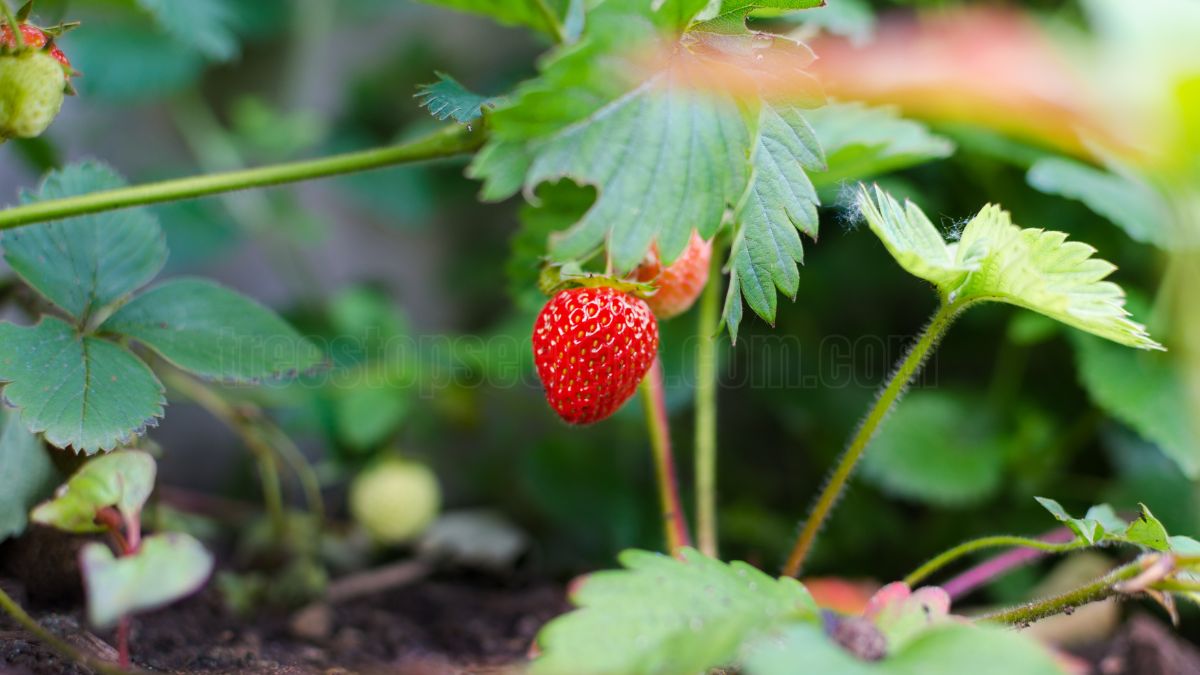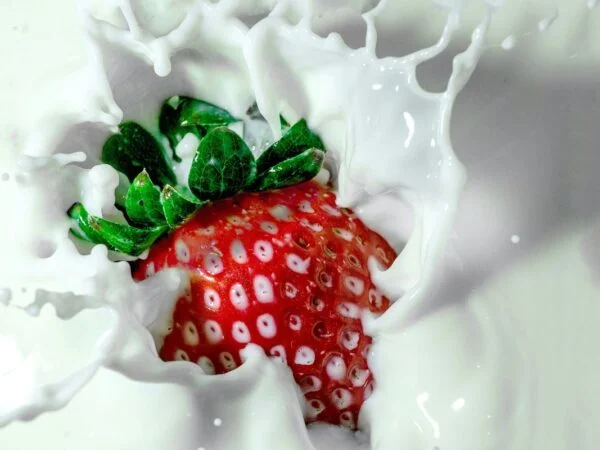Growing strawberries from a strawberry is an easy, accessible way for anyone to grow their own sweet, succulent strawberries.
First, select a ripe, healthy-looking strawberry. Choose one that has seeds on its outside, because those seeds will sprout into new plants.
Use a small pot with well-draining soil, and place it in a sunny area. Carefully plant the strawberry, covering it lightly with soil and keeping the soil consistently moist.
After a few weeks, you’ll notice new shoots starting to form. Don’t forget to keep them well watered and in full sun, and soon these little shoots will become productive strawberry plants.
Follow our in-depth strawberry growing instructions and advice to have a productive strawberry patch that makes your gardening efforts worthwhile.
Key Takeaways
- Choose nutrient-rich, well-draining soil with a pH of 6.0 to 6.8 to give strawberries the best foundation for growth. Improve soil structure and nutrient content by mixing in organic material such as compost or peat moss.
- Pick strawberry types known to do well in your region’s climate, including everbearing and June-bearing varieties. Choose disease resistant varieties. This will minimize maintenance and maximize yield.
- Harvest seeds from ripe strawberries, taking care not to crush or bruise the seeds. If possible, store seeds in a cool, dry place for at least three weeks before sowing to improve germination.
- Keep the soil evenly moist and use mulch to encourage healthy root growth and prevent weeds. Monitor soil moisture and when it becomes dry, water thoroughly to avoid drought stress.
- Keep an eye on your plants for pests and disease, using organic methods and friendly bugs to combat pests. Use crop rotation and appropriate spacing to help prevent disease spread and keep plants healthy.
- Pick strawberries when they are deep red, sweet smelling and ripe, cutting them off with scissors to prevent bruising. Be sure to store harvested berries properly to extend shelf life, using techniques such as refrigeration or freezing if you plan to use them later.
Understanding Strawberry Cultivation
Soil attributes Successful strawberry production depends on multiple soil factors as well as cultivar choice. Having a grasp of these factors goes a long way towards establishing vigorous plants and bountiful crops.
What Soil Characteristics Are Ideal?
Strawberries prefer rich, loamy soil that is well draining and has a pH range of 6.0 to 6.8. To improve soil quality, use amendments like compost, peat moss, or aged manure. These amendments can greatly improve soil structure and nutrient and water availability.
This makes ongoing scrutiny of drainage an absolute necessity. The worst form of strawberry death, root rot, is a prevalent hazard stemming from poor drainage. Fertile soils help ensure a balance of vegetative and reproductive growth, which is important for healthy plants that make quality fruit.
To keep strawberries thoroughly hydrated, they need regular soil moisture, which can be provided by approximately 1 inch of rain per week.
How to Choose the Right Strawberry Varieties
It is critical to choose the proper strawberries for your growing climate. Everbearing varieties produce fruit steadily during much of the growing season. In comparison, June-bearing varieties produce a smaller harvest all at once during the mid-June to early July period.
Day neutral strawberries are a third possibility, which bear fruit through a longer period of the season. It is always a good idea to select disease-resistant varieties, as they require less upkeep and offer better yield overall.
Keep in mind that all strawberry varieties take about 30 days from bloom to harvest.
What Role Does Companion Planting Play?
Planting strawberries alongside other plants could save you money and improve your crop. Plants such as basil, onions, and marigolds can improve strawberry vitality by repelling pests and helping to attract pollinators.
By planting strawberries with the right complementary crops, you’ll get the most out of your garden space, all while helping to protect your garden’s ecosystem.
Propagating Strawberries from a Single Fruit
Growing strawberries from one strawberry is a fun and satisfying project. With each strawberry containing hundreds of seeds, it’s easy to see how one can grow many new plants. Dark, rich soil isn’t enough — to achieve successful germination and growth, you need to be attentive to detail.
1. Step-by-Step Process for Seed Extraction
Start by sourcing ripe, robust strawberries, as global produce often carries root-sterilizing chemicals that prevent sprouting. Cut the strawberries to expose the seeds and let them dry out for a day or two. This drying process helps facilitate seed removal.
With a small tool, like a toothpick, gently pick out the seeds, being careful not to puncture them. Once extracted, it helps to store these seeds in a cool, dry place for a minimum of three weeks before use to improve their viability.
2. Sowing Seeds for Successful Germination
To sow the seeds properly, you will want to mix high-quality potting soil with soil made for seed starting. Seeds should be sown, or if they’re already on the surface, pressed down, at a very shallow depth, no more than lightly covering them with soil.
Keep the seeds warm and moist—this is key, since strawberry seeds need cold-stratification to germinate. The typical approach is to cold-stratify seeds by putting them in the refrigerator for 4-6 weeks.
After this time, they are ready to be transplanted either indoors or outside, as long as they are shielded from harmful pests.
3. Transplanting Techniques for Young Plants
As seedlings grow, start acclimating them to transplanting conditions by hardening them off. This part of the transplanting process is the start of hardening off the young plants to outdoor conditions.
Space the transplants properly for good airflow and vigorous growth. Regardless of your method, after transplanting, make sure to water deeply to encourage young roots to grow into their new home.
Preparing the Planting Environment
Preparing a good planting environment is important to establish healthy, productive strawberry plants. First thing’s first—determine how much sun your plants will get.
Sunlight Strawberry plants grow best in full sun, so provide them with at least six to eight hours of direct sunlight each day. Too little light can stifle growth and limit fruit set.
Best Practices for Soil Preparation
Soil tests Before planting, test your soil’s pH and nutrient levels. This allows for targeted amendments, building the soil to produce and sustain healthy plants.
To improve fertility and soil structure, mix in organic materials like compost. Leveling the planting area helps avoid future water pooling, leading to more even moisture distribution.
Creating Optimal Conditions for Root Development
Keeping moisture levels even in the soil is important for root development. Mulch is a great way to conserve moisture and keep weeds down around your new plants.
Avoid compaction and create proper drainage to eliminate areas of stagnant water. In addition, standing water promotes root rot and prevents the establishment of robust root structures.
Timing and Climate Considerations for Planting
Timing Considerations for Planting Timing is key. Decide when will be the ideal time to plant based on your local last frost dates and climate.
Don’t plant when there are drastic temperature changes, because these will put added stress on the plants. Making planting decisions based on seasonal warming or cooling will help set seedlings up for maximum growth potential.
Essential Care for Strawberry Plants
There are some essential practices that are key to caring for strawberry plants. Consistent watering, the correct type of fertilization, and making sure to weed often are all important parts of this step.
Watering Requirements for Healthy Growth
Strawberries are happiest when their feet (roots) are kept moist but not soggy. Deep watering once a week is important, letting the soil dry out slightly between watering.
Using drip irrigation or soaker hoses is one of the best ways to reduce water waste and stop fungal diseases. Monitor the plants for symptoms of drought stress. When you start to notice that your strawberry plants’ leaves are wilting, it may be time to change things up.
Fertilizing Techniques to Boost Yield
Proper fertilization not only keeps your strawberry plants healthier, but it increases fruit yield. Applying balanced fertilizers throughout the growing season will help stimulate lush growth.
Organic fertilizers, such as compost or fish emulsion, can amend the soil in a natural, sustainable way. By timing fertilization with the plants’ growth stages, you’ll further optimize nutrient availability and absorption to maximize their effectiveness.
Weeding Practices to Maintain Plant Health
Weeds are one of the most damaging foes to strawberries, competing for valuable nutrients. Regular inspections of the garden for weeds are very important, and prompt removal can minimize this competition.
Applying mulch, such as straw and pine needles, will help deter weeds and keep the moisture in the soil. Hand-weeding is usually the safest method so that you don’t damage the sensitive strawberry roots, but it will keep your plants healthy and highly productive.
Managing Pests and Diseases
Strawberries require constant attention to prevent pests and diseases from damaging healthy plants and reducing a fruitful harvest. Major pests include slugs—feeding on leaves and stems, slugs are one of the most damaging feeders. Consistent, thorough inspection is the best defense against these potential infestations.
Preventive measures include:
- Keeping the garden clean by removing debris.
- Ensuring proper drainage to avoid water accumulation.
- Using companion planting to deter pests naturally.
Common Fungal Infections and Their Management
Common fungal infections such as gray mold and root rot are extremely dangerous to strawberry plants. Symptoms include sudden wilting, rotting fruit, and a fluffy gray coating on infected leaves and stems.
To control these, practice crop rotation and give plants enough room to ensure good airflow between plants. Organic fungicides, like chlorothalonil or mancozeb, can be used preventatively during wet periods to prevent outbreaks.
Effective Pest Control Strategies
Floating row covers and other physical barriers can be used to protect young plants from pests, while still allowing sunlight and rainfall to penetrate. Releasing beneficial insects, such as ladybugs, is a natural way to control aphid populations.
Annual crop rotations can break the annual life cycles of pests, preventing new infestations from becoming established.
Organic Practices for Sustainable Strawberry Care
Implementing organic gardening practices not only improves strawberry plant health, but benefits the environment. Organic pest repellents like neem oil tackle pest issues without the use of toxic chemicals.
Attracting biodiversity to your garden creates a healthy ecosystem, making it easier for nature to manage pests.
Harvesting Strawberries Effectively
How you harvest strawberries is an important process that can make a huge difference in the quality and flavor of the fruit. By monitoring for ripeness and using the right harvesting methods, you can make sure your strawberries are harvested when they’re the most flavorful.
Signs of Ripeness to Look For
When trying to decide when to harvest, look for the following signs that indicate ripeness. A uniform deep red color is a sure sign that a strawberry is ripe. Another sign that the fruit is ready is the delicious fragrance of the berry.
The texture is important too; ripe strawberries will be firm but a little soft to the touch if you give them a light squeeze. For the richest taste, harvest berries that are fully colored. Dodge those that have any green, white, or otherwise off-color spots.
Techniques for Harvesting Without Damage
To reduce injury to the berries while harvesting, use scissors or pruning shears to cleanly cut strawberries free from the plant. This technique minimizes potential bruising. Gentle handling is the number one rule.
Strawberries are very soft and can be bruised by excessive pressure. To get the best flavor into your berry, pick them in the morning when both you and your fruit are cool, preventing damage and loss of quality.
Post-Harvest Care to Maintain Quality
After strawberries are harvested, the cool drying method will make their freshness last longer. Do not wash them until just before you plan to eat them or they will spoil.
Use containers that are breathable to ensure airflow, which will prevent moisture accumulation and the potential for mold growth.
Storing and Enjoying Your Strawberries
Using and storing strawberries properly will help improve their taste and your enjoyment! Learning the best ways to keep them fresh and new ways to enjoy them will make sure you get the most flavor out of your garden bounty.
Best Methods for Storing Fresh Strawberries
To maintain the quality of fresh strawberries, consider these effective storage techniques:
- Always refrigerate strawberries in a single layer, so the berries don’t get crushed and bruise.
- It’s best to store them in an airtight container lined with paper towels to soak up any extra moisture that will cause them to spoil.
- To store strawberries long-term, wash and dry strawberries completely before freezing. This technique captures their deliciousness and natural goodness.
Creative Ways to Use Your Harvest
Strawberries are a versatile ingredient to use in the kitchen. Enjoy them fresh in various ways:
- Puree them into smoothies for an icy cold treat, or sprinkle over salads for a fun flavor kick.
- Learn preservation techniques like canning or jarring to create strawberry jams, jellies, or sauces to enjoy their flavor all year long.
- Add strawberries to sweet baked items such as muffins or cakes, adding flavor and color.
Tips for Preserving Strawberries Long-Term
For those looking to extend the shelf life of strawberries, consider these preservation tips:
- Foodsaver bags Vacuum sealing is a great way to preserve your frozen strawberries and avoid freezer burn.
- Dehydrating strawberries makes a delicious, one-of-a-kind crunchy treat that holds on to their vital nutrients.
- For best quality and flavor, keep your preserved strawberries in dark, cool places.
Conclusion
The process of growing strawberries from a single strawberry provides an enjoyable and fulfilling hands-on activity. Follow these detailed instructions in our guide to growing strawberries from a strawberry to cultivate a healthy plant from a single fruit. It’s as simple as starting with good quality seed and giving your soil some TLC. Give your plants the right conditions, such as adequate water and sunlight, and see them thrive. Be vigilant against pests and diseases to ensure a bountiful harvest. Once the time is right, savor the delicious fruits of your labor.
Tackle this project and find out just how easy it is to grow your own strawberries! So gather your seeds, put on your gardening gloves, and get growing with strawberries today!
Frequently Asked Questions
How do I start growing strawberries from a strawberry?
Simply cut the fruit in half and press the fleshy part gently into soil. Maintain consistent moisture and warmth to promote germination.
What type of soil is best for strawberries?
What type of soil is best for strawberries Strawberries like sandy, well-drainage loam soil improved with organic matter. Make sure your soil has a pH of 5.5 to 6.5 for best results.
How much sunlight do strawberry plants need?
Sunlight requirements of strawberry plants Strawberry plants do best in full sunlight, with at least 6 to 8 hours of sun exposure each day. This results in a sweeter, juicier fruit.
When is the best time to plant strawberries?
When is the ideal time to grow strawberries. This gives them time to develop a good root system before the growing season begins.
How often should I water my strawberry plants?
Do not allow the soil to dry out completely or become waterlogged. Plan on approximately 1 to 1.5 inches of water weekly.
How can I prevent pests in my strawberry garden?
Be sure to check your plants on a regular basis for any indications of trouble and pick off any rotting fruit.
When should I harvest my strawberries?
When should I harvest my strawberries. Pick the berries when they are completely red and just a bit soft to the touch. This is usually in late spring to early summer, depending on the variety.
Image Source: Paid image from CANVA





